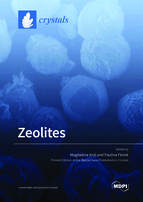Zeolites
A special issue of Crystals (ISSN 2073-4352). This special issue belongs to the section "Inorganic Crystalline Materials".
Deadline for manuscript submissions: closed (20 December 2020) | Viewed by 61477
Special Issue Editors
Interests: zeolites; natural aluminosilicates; sorption; structural studies; FT-IR spectroscopy
Interests: zeolites; geopolymers; structural studies; heavy metals immobilization
Special Issue Information
Dear Colleagues,
Zeolites and zeolite-based materials are characterized by unique physical and chemical properties which result in numerous important applications. These properties arise directly from their specific structure—the system of channels and chambers characterized by well-defined molecular dimensions. If thermal stability, chemical resistance, possibility of generating active sites as well as sorption and ion-exchange properties are taken into account, it is not surprising that zeolites play an extremely important role in various applications of chemical technology, and their importance increases continuously.
Zeolites can be successfully obtained in laboratory conditions by heating the aluminosilicate materials in the presence of alkaline solution. Various silica carriers, including natural raw materials (such as kaolinite, volcanic glasses, diatomite) and industrial wastes (among which fly ash is the most popular) are used in such processes. Current trends provide a green and economic alternative for the synthesis of zeolites using natural or waste clays instead of chemical raw materials.
This Special Issue aims to attract original contributions in topics related to zeolites, covering aspects ranging from the preparation of such materials (especially using natural or waste materials), their characterization, and application in different areas. In particular, reports on the unique synthesis methods of zeolites or improvement of existing ones, as well as structural characterization of resulting materials and their potential use in various fields are welcome.
I believe that this collection will summarize the current state-of-the-art in the field of zeolitic materials and will become a source of new ideas resulting in the development of this group of minerals."
Dr. Magdalena Król
Ms. Paulina Florek
Guest Editors
Manuscript Submission Information
Manuscripts should be submitted online at www.mdpi.com by registering and logging in to this website. Once you are registered, click here to go to the submission form. Manuscripts can be submitted until the deadline. All submissions that pass pre-check are peer-reviewed. Accepted papers will be published continuously in the journal (as soon as accepted) and will be listed together on the special issue website. Research articles, review articles as well as short communications are invited. For planned papers, a title and short abstract (about 100 words) can be sent to the Editorial Office for announcement on this website.
Submitted manuscripts should not have been published previously, nor be under consideration for publication elsewhere (except conference proceedings papers). All manuscripts are thoroughly refereed through a single-blind peer-review process. A guide for authors and other relevant information for submission of manuscripts is available on the Instructions for Authors page. Crystals is an international peer-reviewed open access monthly journal published by MDPI.
Please visit the Instructions for Authors page before submitting a manuscript. The Article Processing Charge (APC) for publication in this open access journal is 2600 CHF (Swiss Francs). Submitted papers should be well formatted and use good English. Authors may use MDPI's English editing service prior to publication or during author revisions.
Keywords
- Zeolites
- Hydrothermal synthesis
- Alkali activation
- Zeolite properties
- Zeolite characterization
- Zeolite applications







